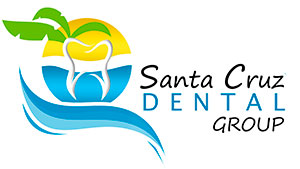
Services


Services
Click the icons below to learn more
Braces
Clear Correct
Is a clear aligner system used to straighten teeth as an alternative to traditional braces. Similar to other clear aligner brands (like Invisalign) available to dentists or orthodontists certified to offer them to their patients, ClearCorrect straightens teeth using a series of clear, custom-made, removable aligners that gradually move teeth a little bit at a time, eventually correcting the teeth and smile to elicit a new, revitalized look.
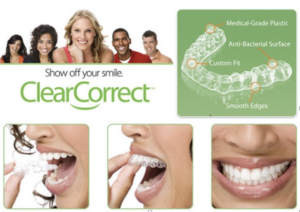
How it works?
ClearCorrect treatment involves four phases of aligner therapy. Each phase requires a new set of aligners that are worn for a three-week period. The time between each phase allows for control and flexibility.
ClearCorrect aligners are worn all the time, except when eating and drinking, or while brushing and flossing. Designed with aesthetics in mind, the aligners are barely noticeable and won’t have an impact on your daily routine.
After wearing each aligner set, results will be noticeable as your teeth begin slowly adjusting and aligning to your desired smile. Periodic check-ups with your dentist are required so your progress can be evaluated and you can be given the next set of aligners. This sequence will continue until you have achieved your new smile.
Treatment time can vary from one to two years, depending upon your specific condition and degree of misalignment. There are three treatment options available:
- Unlimited: Patients are provided with as many aligners needed to complete the case.
- Limited 12: Patients are provided with 12 sets of aligners.
- Limited 6: Patients are provided with 6 sets of aligners.
The cost of treatment varies from option to option, with Unlimited at the top of the cost spectrum. To determine the best treatment option for you and to further evaluate costs, set up a consultation with a ClearCorrect provider in your area.
Who Can Benefit?
ClearCorrect currently is available to treat adults and teenagers. (Compare with Invisalign Teen.) Children who might not have all of their molars and senior citizens who present with more complicated dental cases also may be candidates for ClearCorrect but should consult with their dentists to determine the treatment option that best suits their needs.
ClearCorrect can be used to treat the following orthodontic conditions:
- Crowded teeth
- Spacing between teeth
- Overbites
- Underbites
- Crooked or turned (rotated) teeth
Gingivoplasty

Is the surgical reshaping of gum tissue around the teeth. It is often is done simply to make gums look better. They may have an unusual shape or may not be formed normally. The causes can include a person’s genes, disease or trauma. Gingivoplasty reshapes the gums to make them look more natural. It often is done alone, but can be done during or after a gingivectomy. Gingivoplasty also can be done along with a gum graft. This type of surgery adds tissue to the gum line.
Veneers
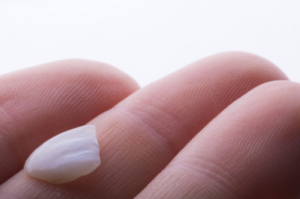 Veneers are very thin pieces of durable, tooth shaped porcelain that are custom made (for shape and color) by a professional dental laboratory. They are bonded onto the front of teeth to create a beautiful and attractive smile.
Veneers are very thin pieces of durable, tooth shaped porcelain that are custom made (for shape and color) by a professional dental laboratory. They are bonded onto the front of teeth to create a beautiful and attractive smile.
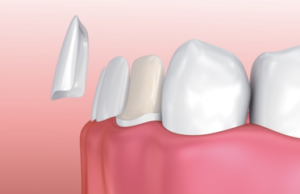 Veneers can completely reshape your teeth and smile. They can often be alternatives to crowns and the ideal solution in treating many dental conditions.
Veneers can completely reshape your teeth and smile. They can often be alternatives to crowns and the ideal solution in treating many dental conditions.
As with most dental restorations, veneers are not permanent and may someday need replacement. They are very durable and will last many years, giving you a beautiful long lasting smile.
Reasons for Porcelain Veneers:
- Cosmetically, to create a uniform, white, beautiful smile.
- Crooked teeth.
- Misshapen teeth.
- Severely discolored or stained teeth.
- Teeth that are too small or large.
- Unwanted or uneven spaces.
- Worn or chipped teeth.
 Oral sedation
Oral sedation
Oral sedation dentistry is a medical procedure involving the administration of oral sedative drugs, generally to facilitate a dental procedure and reduce patients fear and anxiety related to the experience.
Nitrous oxide

Is a safe and effective sedative agent that is mixed with oxygen and inhaled through a small mask that fits over your nose to help you relax. Nitrous oxide sometimes called “laughing gas,” is one option your dentist may offer to help make you more comfortable during certain procedures.
Dental Hygiene
The regular cleaning
Professional dental cleanings (dental prophylaxis) are usually performed by Registered Dental Hygienists. Your cleaning appointment will include a dental exam and the following: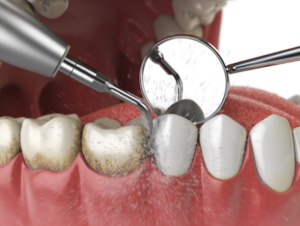
- Removal of calculus (tartar): Calculus is hardened plaque that has been left on the tooth for some time and is now firmly attached to the tooth surface. Calculus forms above and below the gum line and can only be removed with special dental instruments.
- Removal of plaque: Plaque is a sticky, almost invisible film that forms on the teeth. It is a growing colony of living bacteria, food debris, and saliva. The bacteria produce toxins (poisons) that inflame the gums. This inflammation is the start of periodontal disease!
- Teeth polishing: Remove stain and plaque that is not otherwise removed during tooth brushing and scaling.
Deep Cleaning Process
Involves removing plaque and tartar from the surface of the teeth and from the pocket area between the teeth and gums. The dental hygienist can perform scaling and root planing using either electriceor ultrasonic instruments or manual scaling tools.
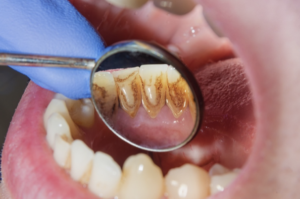
The Need for Deep Cleaning
When going to the dentist, the dental hygienist will use an instrument called a probe to measure the area around your teeth to see if you have any pocketing (area between the tooth and gum where bacteria will form). Ideally, normal healthy pockets will be no more than 3 millimeters deep, If the pockets are greater than 5 millimeters, your dentist might prescribe a deep scaling and root planing appointment with the dental hygienist.
Common Signs & Symptoms
If you have any of these signs or symptoms, the advice of a general dentist or periodontist should be sought as soon as possible:
- Unexplained bleeding – Bleeding when brushing, flossing or eating food is one of the most common symptoms of a periodontal infection. The toxins in plaque cause a bacterial infection which makes the tissues prone to bleeding.
- Pain, redness or swelling – A periodontal infection may be present if the gums are swollen, red or painful for no apparent reason. It is essential to halt the progression of the infection before the gum tissue and jaw bone have been affected. It is also critical to treat the infection before it is carried into the bloodstream to other areas of the body.
- Longer-looking teeth – Periodontal disease can lead to gum recession. The toxins produced by bacteria can destroy the supporting tissue and bones, thus making the teeth look longer and the smile appear more “toothy.”
- Bad breath/halitosis – Although breath odor can originate from back of the tongue, the lungs and stomach, from the food we consume, or from tobacco use, bad breath may be caused by old food particles which sit between the teeth and underneath the gum line. The deeper gum pockets are able to house more debris and bacteria, causing a foul odor.
- Loose teeth/change in bite pattern – A sign of rapidly progressing periodontitis is the loosening or shifting of the teeth in the affected area. As the bone tissue gets destroyed, teeth that were once firmly attached to the jawbone become loose or may shift in position.
- Pus – Pus oozing from between the teeth is a definitive sign that a periodontal infection is in progress. The pus is a result of the body trying to fight the bacterial infection.
Dentures
A denture is a removable dental appliance replacement for missing teeth and surrounding tissue. They are made to closely resemble your natural teeth and may even enhance your smile.
There are two types of dentures – complete and partial dentures. Complete dentures are used when all of the teeth are missing, while partial dentures are used when some natural teeth remain. A Partial denture not only fills in the spaces created by missing teeth, it prevents other teeth from shifting.
A Complete denture may be either “conventional” or “immediate.” A conventional type is made after the teeth have been removed and the gum tissue has healed, usually taking 4 to 6 weeks. During this time the patient will go without teeth. Immediate dentures are made in advance and immediately placed after the teeth are removed, thus preventing the patient from having to be without teeth during the healing process. Once the tissues shrink and heal, adjustments will need to be made.
Dentures are very durable appliances and will last many years, but may have to be remade, repaired, or readjusted due to normal wear.
Reasons for dentures:
- Complete Denture – Loss of all teeth in an arch.
- Partial Denture – Loss of several teeth in an arch.
- Enhancing smile and facial tissues.
- Improving chewing, speech, and digestion.
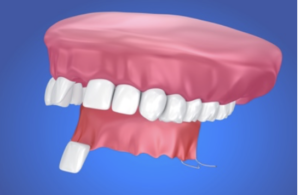
What does getting dentures involve?
The process of getting dentures requires several appointments, usually over several weeks. Highly accurate impressions (molds) and measurements are taken and used to create your custom denture. Several “try-in” appointments may be necessary to ensure proper shape, color, and fit. At the final appointment, The Dr. will precisely adjust and place the completed denture, ensuring a natural and comfortable fit.
It is normal to experience increased saliva flow, some soreness, and possible speech and chewing difficulty, however this will subside as your muscles and tissues get used to the new dentures.
You will be given care instructions for your new dentures. Proper cleaning of your new dental appliance, good oral hygiene, and regular dental visits will aid in the life of your new dentures.

Dental Implants
Dental implants are a great way to replace missing teeth and also provide a fixed solution to having removable partial or complete dentures. Implants provide excellent support and stability for these dental appliances.

Dental implants are artificial roots and teeth (usually titanium) that are surgically placed into the upper or lower jaw bone by a dentist. The teeth attached to implants are very natural looking and often enhance or restore a patient’s smile!
Dental implants are very strong, stable, and durable and will last many years, but on occasion, they will have to be re-tightened or replaced due to normal wear.
Reasons for dental implants:
- Replace one or more missing teeth without affecting adjacent teeth.
- Resolve joint pain or bite problems caused by teeth shifting into missing tooth space.
- Restore a patient’s confident smile.
- Restore chewing, speech, and digestion.
- Restore or enhance facial tissues.
- Support a bridge or denture, making them more secure and comfortable.

What does getting dental implants involve?
The process of getting implants requires a number of visits over several months.
X-rays and impressions (molds) are taken of the jaw and teeth to determine bone, gum tissue, and spacing available for an implant. While the area is numb, the implant will be surgically placed into the bone and allowed to heal and integrate itself onto the bone for up to six months. Depending on the type of implant, a second surgery may be required in order to place the “post” that will hold the artificial tooth in place. With other implants the post and anchor are already attached and placed at the same time.
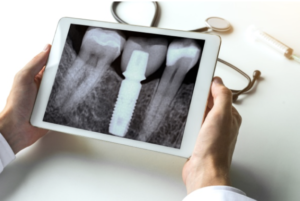
After several weeks of healing the artificial teeth are made and fitted to the post portion of the anchor. Because several fittings may be required, this step may take one to two months to complete. After a healing period, the artificial teeth are securely attached to the implant, providing excellent stability and comfort to the patient.
You will receive care instructions when your treatment is completed. Good oral hygiene, eating habits, and regular dental visits will aid in the life of your new implant.
Oral Surgery
Extractions
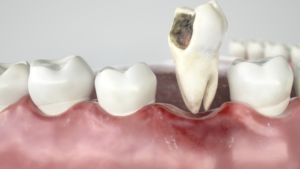
What Is It?
Tooth extraction is the removal of a tooth from its socket in the bone.
What It’s Used For
If a tooth has been broken or damaged by decay, your dentist will try to fix it with a filling, crown or other treatment. Sometimes, though, there’s too much damage for the tooth to be repaired. In this case, the tooth needs to be extracted. A very loose tooth also will require extraction if it can’t be saved, even with bone replacement surgery (bone graft).
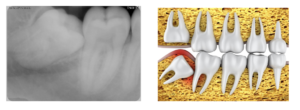
Here are other reasons:
- Some people have extra teeth that block other teeth from coming in.
- Sometimes baby teeth don’t fall out in time to allow the permanent teeth to come in.
- People getting braces may need teeth extracted to create room for the teeth that are being moved into place.
- People receiving radiation to the head and neck may need to have teeth in the field of radiation extracted.
- People receiving cancer drugs may develop infected teeth because these drugs weaken the immune system. Infected teeth may need to be extracted.
- Some teeth may need to be extracted if they could become a source of infection after an organ transplant. People with organ transplants have a high risk of infection because they must take drugs that decrease or suppress the immune system.
- Wisdom teeth, also called third molars, are often extracted either before or after they come in. They commonly come in during the late teens or early 20s. They need to be removed if they are decayed, cause pain or have a cyst or infection. These teeth often get stuck in the jaw (impacted) and do not come in. This can irritate the gum, causing pain and swelling. In this case, the tooth must be removed. If you need all four wisdom teeth removed, they are usually taken out at the same time.
If you expect to have treatment with intravenous drugs called bisphosphonates for a medical condition, be sure to see your dentist first. If any teeth need to be extracted, this should be done before your drug treatment begins. Having a tooth extraction after bisphosphonate treatment increases the risk of osteonecrosis (death of bone) in the jaw.
Preventative
Dental Sealants
A sealant is a thin, plastic coating applied to the chewing surface of molars, premolars and any deep grooves (called pits and fissures) of teeth. More than 75% of dental decay begins in these deep grooves. Teeth with these conditions are hard to clean and are very susceptible to decay. A sealant protects the tooth by sealing deep grooves, creating a smooth, easy to clean surface.
Sealants can protect teeth from decay for many years, but need to be checked for wear and chipping at regular dental visits.
BEFORE – AFTER
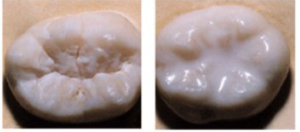
Reasons for sealants:
- Children and teenagers – As soon as the six-year molars (the first permanent back teeth) appear or any time throughout the cavity prone years of 6-16.
- Adults – Tooth surfaces without decay that have deep grooves or depressions.
- Baby teeth – Occasionally done if teeth have deep grooves or depressions and child is cavity prone.
Six-month recall dental appointments or Maintenance
It only takes twenty-four hours for plaque that is not removed from your teeth to turn into calculus (tartar)! Daily home cleaning helps control plaque and tartar formation, but those hard to reach areas will always need special attention.
Once your periodontal treatment has been completed, your dentist and dental hygienist will recommend that you have regular maintenance cleanings (periodontal cleanings), usually four times a year. At these cleaning appointments, the pocket depths will be carefully checked to ensure that they are healthy. Plaque and calculus that is difficult for you to remove on a daily basis will be removed from above and below the gum line.
In addition to your periodontal cleaning and evaluation, your appointment will usually include:

- Examination of diagnostic x-rays (radiographs): Essential for detection of decay, tumors, cysts, and bone loss. X-rays also help determine tooth and root positions.
- Examination of existing restorations: Check current fillings, crowns, etc.
- Examination of tooth decay: Check all tooth surfaces for decay.
- Oral cancer screening: Check the face, neck, lips, tongue, throat, cheek tissues, and gums for any signs of oral cancer.
- Oral hygiene recommendations: Review and recommend oral hygiene aids as needed. (Electric toothbrushes, special periodontal brushes, fluorides, rinses, etc.)
- Teeth polishing: Remove stain and plaque that is not otherwise removed during tooth brushing and scaling.
Good oral hygiene practices and periodontal cleanings are essential in maintaining dental health and keeping periodontal disease under control!
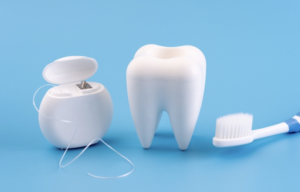
Tooth brushing and flossing Technical
A beautiful, healthy smile that lasts a lifetime is our ultimate goal when treating patients. Your personal home care plays an important role in achieving that goal. Your personal home care starts by eating balanced meals, reducing the number of snacks you eat, and correctly using the various dental aids that help control the plaque and bacteria that cause dental disease.
Tooth brushing
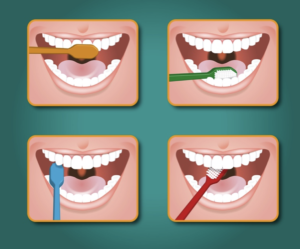
Brush your teeth at least twice a day (especially before going to bed at night) with an ADA-approved soft bristle brush and toothpaste.
- Place the brush at a 45-degree angle to the gums and gently brush using a small, lineal motion, ensuring that you always feel the bristles on the gums.
- Brush the outer, inner, and biting surfaces of each tooth.
- Use the tip of the brush to clean the inside of the front teeth.
- Brush your tongue to remove bacteria and freshen your breath.
Electric toothbrushes are also recommended. They are easy to use and can remove plaque efficiently. Simply place the bristles of the electric brush on your gums and teeth and allow the brush to do its job, several teeth at a time.
Flossing
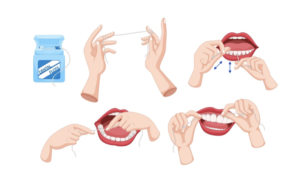
Daily flossing is the best way to clean between the teeth and under the gum line. Flossing not only helps clean these spaces, it disrupts plaque colonies from building up, preventing damage to the gums, teeth, and bone.
- Take 12-16 inches (30-40cm) of dental floss and wrap it around your middle fingers, leaving about 2 inches (5 cm) of floss between the hands.
- Using your thumbs and forefingers to guide the floss, gently insert the floss between teeth using a sawing motion.
- Curve the floss into a “C” shape around each tooth and under the gum line. Gently move the floss up and down, cleaning the side of each tooth.
Floss holders are recommended if you have difficulty using conventional floss.
Rinsing 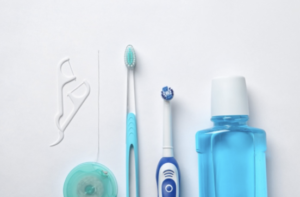 It is important to rinse your mouth with water after brushing, and also after meals if you are unable to brush. If you are using an over-the-counter product for rinsing, it’s a good idea to consult with your dentist or dental hygienist on its appropriateness for you.
It is important to rinse your mouth with water after brushing, and also after meals if you are unable to brush. If you are using an over-the-counter product for rinsing, it’s a good idea to consult with your dentist or dental hygienist on its appropriateness for you.
Use other dental aids as recommended by your dentist or dental hygienist: Interdental brushes, rubber tip stimulators, tongue cleaners, irrigation devices, fluoride, medicated rinses, etc., can all play a role in good dental home care.
Whitening
In-office teeth whitening
 Are you considering teeth whitening to help reinvigorate a smile tainted by discoloration? Professional, in-office teeth whitening is the most popular cosmetic dental procedure in the world today. Unlike home-use systems that incorporate low-dose bleaching agents, in-office whitening takes place under carefully monitored conditions which allow for the safe, controlled, pain-free use of a relatively high concentration of bleaching gel – yielding results that are visible immediately.
Are you considering teeth whitening to help reinvigorate a smile tainted by discoloration? Professional, in-office teeth whitening is the most popular cosmetic dental procedure in the world today. Unlike home-use systems that incorporate low-dose bleaching agents, in-office whitening takes place under carefully monitored conditions which allow for the safe, controlled, pain-free use of a relatively high concentration of bleaching gel – yielding results that are visible immediately.
 Advantages
Advantages
- Produces fastest results.
- This is the safest form of bleaching.
- Gum and tooth sensitive (formerly drawbacks to in-office bleaching) are more controllable today due to thicker peroxide gels (that don’t soak into the teeth as much as previous gels) and the use of desensitizers such as potassium nitrate and fluoride.
Home teeth whitening
 Professional in-home whitening kits aren’t something you can pull off the shelf. Custom-made trays (dental cups fitted to the contour of your teeth) must be manufactured in order to ensure the whitening solution are properly distributed. Without these, a lot of the solution could be wasted or put onto areas of the mouth that may be damaged.
Professional in-home whitening kits aren’t something you can pull off the shelf. Custom-made trays (dental cups fitted to the contour of your teeth) must be manufactured in order to ensure the whitening solution are properly distributed. Without these, a lot of the solution could be wasted or put onto areas of the mouth that may be damaged.
There are several steps to obtaining and using in-home teeth whitening kit:
- Impressions would first be taken of both your upper and lower teeth using non-toxic dental putty. These would be sent to a specialty lab to make the trays. This part of the process takes around one to two weeks from start to finish.
- In the meantime, the initial shade of your teeth would be recorded in your dental chart for comparison when the whitening is completed.
- When the trays are ready, an appointment would be set to show you how to properly dispense and apply the solution and other instructions needed to obtain the optimal results.
- Before starting the at-home procedure, you would need to brush, floss and rinse completely.
- The procedure itself is typically performed an hour per day for two weeks, Certain brands can be worn overnight. You would need to avoid eating, drinking, or smoking while wearing the trays and continue to do the same for 30 minutes after.
TMJ Therapy
Occlusal Guard or Night Guard
An Occlusal Guard (Night Guard) is a horseshoe shaped piece of plastic which is worn over the teeth to protect them against damage caused by teeth clenching and grinding. It works by creating a physical barrier between your upper and lower teeth so that you bite against the plastic rather than wearing down your teeth. Most people are unaware that they grind (also called bruxism) or clench their teeth as it usually happens when they are sleeping. It is often a person’s partner, or dentist, who first notices that they are grinding their teeth. People tend to go through phases of grinding their teeth, such as during times of stress. It is during these times that you may need to wear a night guard to prevent doing permanent damage to your teeth.
When should I wear my Occlusal Guard?
Occlusal Guards are usually worn at night (Hence they are usually referred to as Night Guards) when people are not able to stop themselves from grinding or clenching their teeth. If you are a severe grinder, your dentist may also recommend that you wear it during the day, but this is not usually required. In our society, stress is always present, to the point where we aren’t even aware that we are under stress, therefore it is recommended to wear nightly.
What is an Occlusal Guard made of? 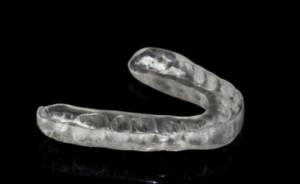
An Occlusal Guard is made of clear hard acrylic. Your Occlusal Guard may become cloudy and discolor over time, but this does not affect functionality of the guard. Occlusal Guards can be made for either the upper or lower teeth, but usually for the upper teeth as they are more comfortable.
How long does an Occlusal Guard last?
How long your night guard will last all depends on the severity of your teeth grinding. Typically, they will last between 5 and 10 years, depending on stress levels. While wearing the Occlusal Guard, you will continue to clench, but the wear will be on the guard and not on your teeth. If you haven’t worn your Occlusal Guard for a while, your teeth may have shifted and the guard may fit very tightly or not at all. Many times, a visit to your dentist for adjustment will be necessary to fix this problem.
Taking care of your Occlusal Guard
When wearing your Occlusal Guard do not eat or drink anything other than water as this may discolor it. After removing your Occlusal Guard in the morning, brush it with your toothbrush and toothpaste and rinse with cold water. Also, never rinse your Occlusal Guard with hot water as this can distort the shape and cause it to no longer fit. When not in use, place in your night guard container and let it air dry.
Custom Made Occlusal Guard Price 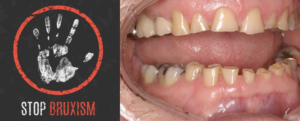
The Occlusal Guard cost will of course vary greatly from dentist to dentist. It can be an extremely worthwhile investment in the long run. It may prevent you from needing more expensive dental work in the future, such as broken fillings, cracked teeth (crowns), and periodontal problems.
Botox
 As TMJ patients search for alternative treatments to manage their pain, a doctor may have suggested the possibility of trying Botox injections directly into the chewing (masseter and temporalis) muscles to relax these muscles. In addition to its well-publicized cosmetic uses, Botox has been approved by the FDA for painful conditions potentially related to TMJ, such as cervical dystonia and migraine.
As TMJ patients search for alternative treatments to manage their pain, a doctor may have suggested the possibility of trying Botox injections directly into the chewing (masseter and temporalis) muscles to relax these muscles. In addition to its well-publicized cosmetic uses, Botox has been approved by the FDA for painful conditions potentially related to TMJ, such as cervical dystonia and migraine.
Occlusal Adjustment
An occlusal adjustment treats the problem that is causing the unhealthy bite. The specific treatment depends on the cause and symptoms of the bite problem. 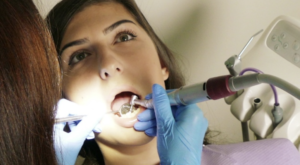
- Reshaping the biting surfaces of the teeth: This involves drilling and filing the misshapen or uneven and rough surfaces of the tooth. This may involve reshaping one tooth or many teeth. Your dentist will check your bite until the teeth have been reshaped and come together correctly when you bite down.
- Reconstruction: The dentist will repair broken and cracked teeth and fill cavities. In some cases, old fillings may need to be removed and replaced with new ones. You may need one or more crowns or your dentist may use bonding agents for repairing damaged teeth. The purpose is to do everything that needs to be done to restore your teeth and your bite to a healthy status.
- Splints or night guards: Your dentist will take impressions of your mouth so the splints or night guards can be made specifically to fit in your mouth and according to your teeth and what needs to be done to align them. Although most guards are worn at night to keep teeth in alignment and to prevent grinding or clenching, some may also be worn during the daytime. Guards are also used for those suffering from TMJ problems and pain.
- Orthodontic treatment with braces and retainers: This realigns and repositions the teeth.
Restorative Dentistry
Inlays and Onlays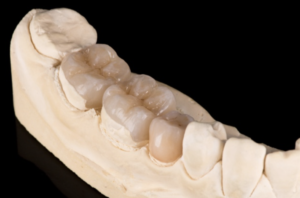
When a tooth is too damaged to support a tooth filling but not damaged enough for a dental crown, you end up somewhere in the middle. Capping a damaged tooth unnecessarily with a dental crown removes more tooth structure than needed. But a large dental filling can weaken the remaining structure of the tooth, causing the tooth to break, crack or eventually need a root canal.
Dental Inlays v. Dental Onlays
Dental inlays and onlays are the same kind of restoration, but they cover different proportions of the tooth. A dental inlay fills the space in between the cusps, or rounded edges, at the center of the tooth’s surface. The dental onlays works like an inlay but covers one or more cusps or the entire biting surface of the tooth. Because of their extensive coverage, dental onlays are sometimes referred to as “partial crowns.”
Composite Fillings
 A composite (tooth colored) filling is used to repair a tooth that is affected by decay, cracks, fractures, etc. The decayed or affected portion of the tooth will be removed and then filled with a composite filling.
A composite (tooth colored) filling is used to repair a tooth that is affected by decay, cracks, fractures, etc. The decayed or affected portion of the tooth will be removed and then filled with a composite filling.
 There are many types of filling materials available, each with their own advantages and disadvantages. Composite fillings, along with silver amalgam fillings, are the most widely used today. Because composite fillings are tooth colored, they can be closely matched to the color of existing teeth and are more aesthetically suited for use in front teeth or the more visible areas of the teeth.
There are many types of filling materials available, each with their own advantages and disadvantages. Composite fillings, along with silver amalgam fillings, are the most widely used today. Because composite fillings are tooth colored, they can be closely matched to the color of existing teeth and are more aesthetically suited for use in front teeth or the more visible areas of the teeth.
As with most dental restorations, composite fillings are not permanent and may someday have to be replaced. They are very durable, and will last many years, giving you a long lasting, beautiful smile.
Reasons for composite fillings:
- Chipped teeth.
- Closing space between two teeth.
- Cracked or broken teeth.
- Decayed teeth.
- Worn teeth.
Root Canal Therapy
Root canal therapy is needed when the nerve of a tooth is affected by decay or infection. In order to save the tooth, the pulp (the living tissue inside the tooth), nerves, bacteria, and any decay are removed and the resulting space is filled with special, medicated, dental materials, which restore the tooth to its full function.
Having a root canal done on a tooth is the treatment of choice to save a tooth that otherwise would die and have to be removed. Many patients believe that removing a tooth that has problems is the solution, but what is not realized is that extracting (pulling) a tooth will ultimately be more costly and cause significant problems for adjacent teeth.
Root canal treatment is highly successful and usually lasts a lifetime, although on occasion, a tooth will have to be retreated due to new infections.
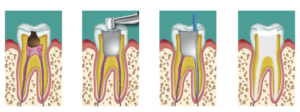 Signs and symptoms for possible root canal therapy:
Signs and symptoms for possible root canal therapy:
- An abscess (or pimple) on the gums.
- Sensitivity to hot and cold.
- Severe toothache pain.
- Sometimes no symptoms are present.
- Swelling and/or tenderness.
Reasons for root canal therapy:
- Decay has reached the tooth pulp (the living tissue inside the tooth).
- Infection or abscess have developed inside the tooth or at the root tip.
- Injury or trauma to the tooth.
What does root canal therapy involve?
A root canal procedure requires one or more appointments and can be performed by a dentist or endodontist (a root canal specialist).
While the tooth is numb, a rubber dam (a sheet of rubber) will be placed around the tooth to keep it dry and free of saliva. An access opening is made on top of the tooth and a series of root canal files are placed into the opening, one at a time, removing the pulp, nerve tissue, and bacteria. If tooth decay is present, it will also be removed with special dental instruments.
Once the tooth is thoroughly cleaned, it will be sealed with either a permanent filling or, if additional appointments are needed, a temporary filling will be placed.
At the next appointment, usually a week later, the roots and the inside cavity of the tooth will be filled and sealed with special dental materials. A filling will be placed to cover the opening on top of the tooth. In addition, all teeth that have root canal treatment should have a crown (cap) placed. This will protect the tooth and prevent it from breaking, and restore it to its full function.
After treatment, your tooth may still be sensitive, but this will subside as the inflammation diminishes and the tooth has healed.
You will be given care instructions after each appointment. Good oral hygiene practices and regular dental visits will aid in the life of your root canal treatment.
Single Crown
A crown (or cap) is a covering that encases the entire tooth surface restoring it to its original shape and size. A crown protects and strengthens tooth structure that cannot be restored with fillings or other types of restorations. 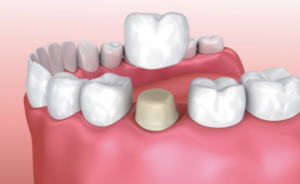
Although there are several types of crowns, e.max or bruxzir (tooth colored crown) are the most popular, because they resemble your natural teeth. They are highly durable and will last many years, but like most dental restorations, they may eventually need to be replaced. Porcelain crowns are made to match the shape, size, and color or your teeth giving you a natural, long-lasting beautiful smile.
Reasons for crowns:
- Broken or fractured teeth.
- Cosmetic enhancement.
- Decayed teeth.
- Fractured fillings.
- Large fillings.
- Tooth has a root canal.
Fixed Bridges
A dental bridge is a fixed (non-removable) appliance and is an excellent way to replace missing teeth.
Porcelain fixed bridges are most popular because they resemble your natural teeth. This type of bridge consists to two crowns that go over two anchoring teeth (abutment teeth) and are attached to pontics (artificial teeth), filling the gap created by one or more missing teeth.
Dental bridges are highly durable and will last many years, however they may need replacement or need to be re-cemented due to normal wear.
Reasons for a fixed bridge:
- Fill space of missing teeth.
- Maintain facial shape.
- Prevent remaining teeth from drifting out of position.
- Restore chewing and speaking ability.
- Restore your smile.
- Upgrade from a removable partial denture to a permanent dental appliance.
Other Services
Digital x-rays
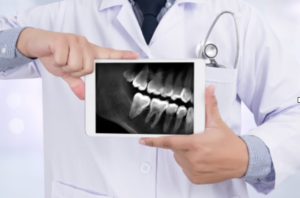
Digital radiography (digital x-ray) is the latest technology used to take dental x-rays. This technique uses an electronic sensor (instead of x-ray film) that captures and stores the digital image on a computer. This image can be instantly viewed and enlarged helping the dentist and dental hygienist detect problems easier. Digital x-rays reduce radiation 80-90% compared to the already low exposure of traditional dental x-rays.
Dental x-rays are essential, preventative, diagnostic tools that provide valuable information not visible during a regular dental exam. Dentists and dental hygienists use this information to safely and accurately detect hidden dental abnormalities and complete an accurate treatment plan. Without x-rays, problem areas may go undetected.
Dental x-rays may reveal:
- Abscesses or cysts.
- Bone loss.
- Cancerous and non-cancerous tumors.
- Decay between the teeth.
- Developmental abnormalities.
- Poor tooth and root positions.
- Problems inside a tooth or below the gum line.
Detecting and treating dental problems at an early stage may save you time, money, unnecessary discomfort, and your teeth!
Are dental x-rays safe?
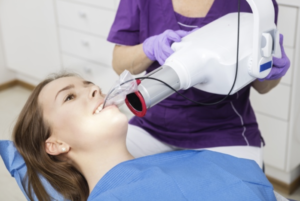
We are all exposed to natural radiation in our environment. Digital x-rays produce a significantly lower level of radiation compared to traditional dental x-rays. Not only are digital x-rays better for the health and safety of the patient, they are faster and more comfortable to take, which reduces your time in the dental office. Also, since the digital image is captured electronically, there is no need to develop the x-rays, thus eliminating the disposal of harmful waste and chemicals into the environment.
Even though digital x-rays produce a low level of radiation and are considered very safe, dentists still take necessary precautions to limit the patient’s exposure to radiation. These precautions include only taking those x-rays that are necessary and using lead apron shields to protect the body.
How often should dental x-rays be taken?
The need for dental x-rays depends on each patient’s individual dental health needs. Your dentist and dental hygienist will recommend necessary x-rays based upon the review of your medical and dental history, a dental exam, signs and symptoms, your age, and risk of disease.
A full mouth series of dental x-rays is recommended for new patients. A full series is usually good for three to five years. Bite-wing x-rays (x-rays of top and bottom teeth biting together) are taken at recall (check-up) visits and are recommended once or twice a year to detect new dental problems.Intra oral Camera
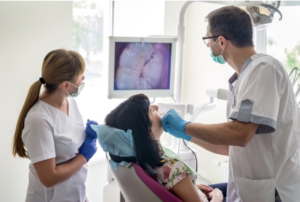
An intra oral camera is a small digital camera, shaped much like a pen, which your dentist or assistant can use to connect to a television screen or computer to display video footage straight from the inside of your mouth. It is your way of seeing what your dentist sees. Intra oral cameras are helpful in understanding exactly what is going on inside your mouth, and its camera function allows photographic records to be stored so your dental progress can be followed accurately over time.
Emergencies
We understand the need to offer same-day appointments, especially when patients are in pain. we’re offering emergency dentistry services. And when you call us unexpectedly needing our help, you can rest assured that you won’t be overcharged or ignored. The next time you find yourself in need of emergency dentistry services, don’t think twice about giving us a call.
The best possible results
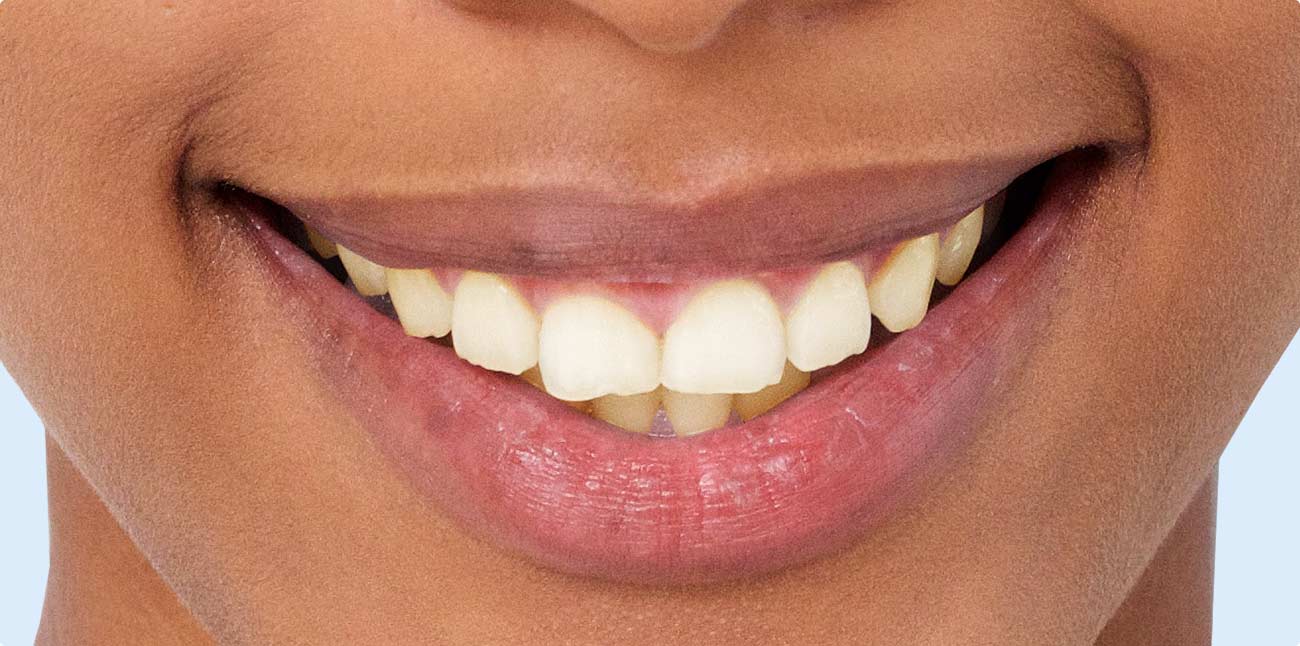
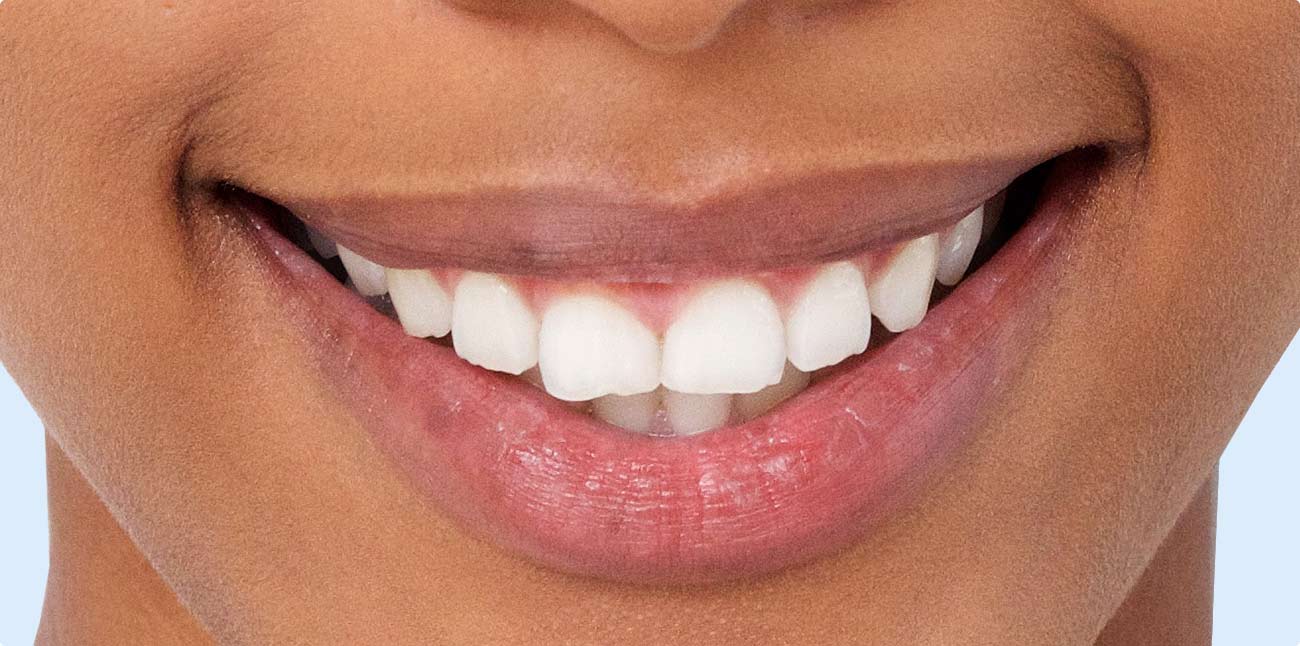
Simply smile away

